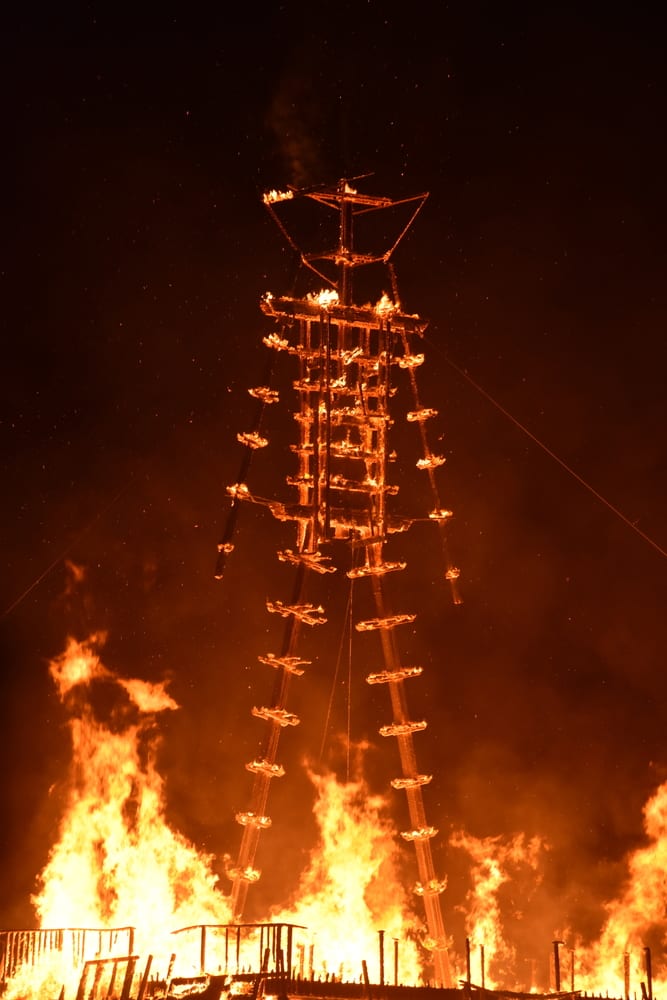The Burning Man Festival, held in the Black Rock Desert of Nevada in August, has chosen its centerpiece structure, a massive wood temple dedicated to the Greek goddess Gaia, that is just one of the many pagan symbols featured at the popular desert gathering.
The festival has certainly evolved from its humble beginnings over 30- years ago when 20 artists gathered on a Beach in San Francisco. The annual event is now a high-profile gathering that attracts over 70,000 to its isolated desert location.
The Burning Man organizers announced two weeks ago that they chose the design for the centerpiece temple of the festival. This year they will build a massive structure composed of 20 wood trusses converging as a spiral. In the center will be a large mandala, a symbol used by Buddhists as an aid in meditation. Designed by Mamou-Mani, a London-based French architect, the structure will be titled Galaxia.

Galaxia is a name taken from a science-fiction novel by Isaac Asimov. In new age mythology, Galaxia is the mother goddess corresponding to the Greek goddess Gaia, but on a higher, galactic, level. In mythology, Gaia is the personification of the Earth and the source of immortality. The worship of Gaia figures prominently in Neopaganism.
The architect was aware of the religious connotations of the structure but denied it was anything other than an aesthetic public gathering space.
“There is no religion, it’s a secular temple. It connects everyone from everywhere,” Mamou-Mani said in an interview with Reno Gazette Journal.
Rabbi Yosef Berger, the rabbi of King David’s Tomb on Mount Zion, disagreed, saying that the focus on religious symbols clearly revealed an intent.
“They are going out to the desert to hide what they are doing because they think God can’t see them there,” Rabbi Berger told Breaking Israel News. “They try to hide their intentions, claiming it is not religious, not idolatry, but their actions reveal their intentions at every turn.”
In fact, the organizers of Burning Man declare a central theme every year. These have included Dante’s Inferno and Fertility. Every festival culminates in the burning of a massive wood effigy based on the neo-pagan/Druid Wicker Man Ritual which replaced human sacrifice. At last year’s Radical Ritual themed festival, a man died after running into the huge Burning Man effigy.
The campground is one large symbol, its boundaries marked off by a huge plastic fence forming a pentagon, an occult symbol used by pagans to outline the five-pointed pentagram star.

Religious symbolism is also prevalent at Catharsis in the Mall, an annual event associated with Burning Man. In addition to a wood temple, the event held in November featured a large sculpture of the Indian goddess Shiva the Destroyer. The two festivals share a 70-foot long seven-headed red metal dragon on wheels. The dragon, named after the ancient Egyptian god Abraxas, was clearly intended to reference Satan as described in the Christian Book of Revelations.

Rabbi Berger accepted this idolatrous trend as a good sign, a necessary precursor to moshiach (Messiah). The rabbi quoted Ecclesiastes to illustrate his point.
The one no less than the other was Hashem’s doing; consequently, man may find no fault with Him. Ecclesiastes 7:14
“We are seeing wondrous progress: the return of the Jews to Israel and Jerusalem, Jews going up to the Temple Mount, the ingathering of the exiles, and the blossoming of the land,” Rabbi Berger said. “Coincidentally, the amount of evil in the world is also rising. We are seeing horrors today never encountered before, both manmade and natural. This is all a prelude and will surely produce something unprecedented.”
Avodah zara (idolatry) is one of the prohibitions included in the Noahide laws, a universal mitzvah (Torah commandment) incumbent upon Jews and non-Jews. Though idolatry seems to contradict modern values, David Nekrutman, the executive director for the Center for Jewish-Christian Understanding and Cooperation (CJCUC), believes that idolatry, as described in the Bible, is currently making a comeback in a different incarnation.
“When you use God for your own ends, that is paganism as practiced by the Egyptians and Mesopotamians,” Nekrutman told Breaking Israel News. “The pagan gods viewed man as lowly, used for their own enjoyment, and man placated the gods in order to get something out of them. The revolution from Abraham was that relating to God had nothing to do with man and everything to do with serving God. Serving God does not mean that he promises you an earthly reward.”
“Post modernism and secularism have a strong aspect of avodah zara. Secularism and materialism are a returning of the focus to ‘me’,” Nekrutman concluded.




